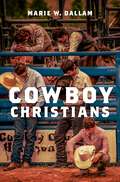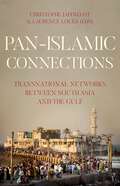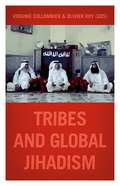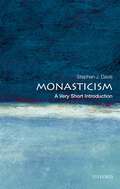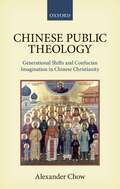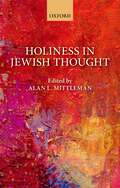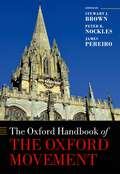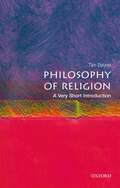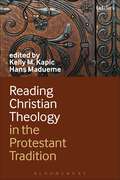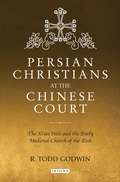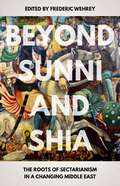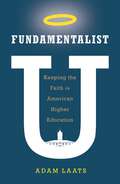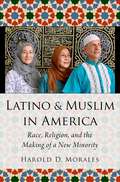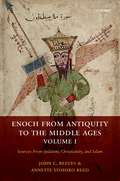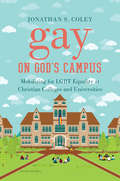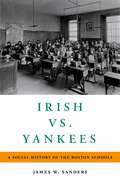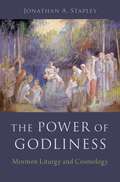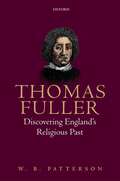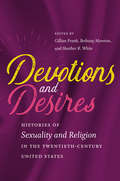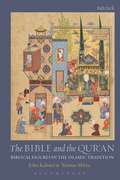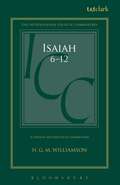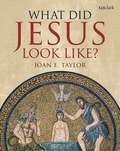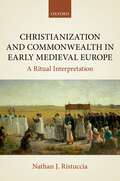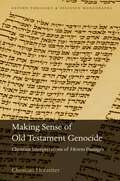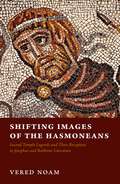- Table View
- List View
Cowboy Christians
by Marie W. DallamCowboy Christians examines the long history of cowboy Christianity in the American West, with a focus on the present-day cowboy church movement. Based on five years of historical and sociological fieldwork in cowboy Christian communities, this book draws on interviews with leaders of cowboy churches, traveling rodeo ministries, and chaplains who serve horse racing and bull riding communities, along with the author's first-hand experiences as a participant observer. Marie W. Dallam traces cowboy Christianity from the postbellum period into the twenty-first century, looking at religious life among cowboys on the range as well as its representation in popular imagery and the media. She examines the structure, theology, and perpetuation of the modern cowboy church, and speculates on future challenges the institution may face, such as the relegation of women to subordinate participant roles at a time of increasing gender equality in the larger society. She also explores the cowboy Christian proclivity for blending the secular and the sacred in leisure environments like arenas, racetracks, and rodeos. Dallam locates the modern cowboy church as a descendant of the muscular Christianity movement, the Jesus movement, and new paradigm church methodology. Cowboy Christians establishes the religious significance of the cowboy church movement, particularly relative to twenty-first-century evangelical Protestantism, and contributes to a deeper understanding of the unique Christianity of the American West.
Pan-Islamic Connections: Transnational Networks Between South Asia and the Gulf
South Asia is today the region inhabited by the largest number of Muslims---roughly 500 million. In the course of the Islamisation process, which begaun in the eighth century, it developed a distinct Indo-Islamic civilisation that culminated in the Mughal Empire. While paying lip service to the power centres of Islam in the Gulf, including Mecca and Medina, this civilisation has cultivated its own variety of Islam, based on Sufism. Over the last fifty years, pan-Islamic ties have intensified between these two regions. Gathering together some of the best specialists on the subject, this volume explores these ideological, educational and spiritual networks, which have gained momentum due to political strategies, migration flows and increased communications. At stake are both the resilience of the civilisation that imbued South Asia with a specific identity, and the relations between Sunnis and Shias in a region where Saudi Arabia and Iran are fighting a cultural proxy war, as evident in the foreign ramifications of sectarianism in Pakistan. Pan-Islamic Connections investigates the nature and implications of the cultural, spiritual and socio-economic rapprochement between these two Islams.
Tribes and Global Jihadism
Across the Muslim world, from Iraq and Yemen, to Egypt and the Sahel, new alliances have been forged between the latest wave of violent Islamist groups ---- -including Islamic State and Boko Haram ---- -and local tribes. But can one now speak of a direct link between tribalism and jihadism, and how analytically useful might it be? Tribes are traditionally thought to resist all encroachments upon their sovereignty, whether by the state or other local actors, from below; yet by joining global organizations such as Islamic State, are they not rejecting the idea of the state from above? This triangular relationship is key to understanding instances of mass 'radicalization', when entire communities forge alliances with jihadi groups, for reasons of self-interest, self-preservation or religious fervor. If Algeria's FIS or Turkey's AKP once represented the 'Islamization of nationalism', have we now entered a new era, the 'tribalization of globalization'?
Monasticism: A Very Short Introduction (Very Short Introductions)
by Stephen J. DavisMonasticism is a social and religious phenomenon which originated in antiquity and which still remains relevant in the twenty-first century. But what, exactly, is it, and how is it distinguished from other kinds of religious and non-religious practice? In this Very Short Introduction Stephen J. Davis discusses the history of monasticism, from our earliest evidence for it, and the different types which have developed from antiquity to the present day. He considers where monasteries are located, from East Asia to North America, and everywhere in between, and how their settings impact the everyday life and worldview of the monks and nuns who dwell there. Exploring how monastic communities are organized, he also looks at how aspects of life like food, sleep, sex, work, and prayer are regimented. Finally, Davis discusses what the stories about saints communicate about monastic identity and ethics, and considers what place there is for monasticism in the modern world. ABOUT THE SERIES: The Very Short Introductions series from Oxford University Press contains hundreds of titles in almost every subject area. These pocket-sized books are the perfect way to get ahead in a new subject quickly. Our expert authors combine facts, analysis, perspective, new ideas, and enthusiasm to make interesting and challenging topics highly readable.
Chinese Public Theology: Generational Shifts and Confucian Imagination in Chinese Christianity
by Alexander ChowIt has been widely recognized that Christianity is the fastest growing religion in one of the last communist-run countries of the world: the People's Republic of China. Yet it would be a mistake to describe Chinese Christianity as merely a clandestine faith or, as hoped by the Communist Party of China, a privatized religion. Alexander Chow argues that Christians in mainland China have been constructing a more intentional public theology to engage the Chinese state and society, since the end of the Cultural Revolution (1966-76). Chinese Public Theology recalls the events which have led to this transformation and examines the developments of Christianity across three generations of Chinese intellectuals from the state-sanctioned Protestant church, the secular academy, and the growing urban renaissance in Calvinism. Moreover, Chow shows how each of these generations have provided different theological responses to the same sociopolitical moments of the last three decades. This study illustrates how a growing understanding of Chinese public theology has been developed through a subconscious intermingling of Christian and Confucian understandings of public intellectualism. These factors result in a contextually-unique understanding of public theology, but also one which is faced by contextual limitations as well. With this in mind, Chow draws from the Eastern Orthodox doctrine of theosis and the Chinese traditional teaching of the unity of Heaven and humanity (Tian ren heyi) to offer a way forward in the construction of a Chinese public theology.
Holiness in Jewish Thought
Holiness is a challenge for contemporary Jewish thought. The concept of holiness is crucial to religious discourse in general and to Jewish discourse in particular. "Holiness" seems to express an important feature of religious thought and of religious ways of life. Yet the concept is ill defined. This collection explores what concepts of holiness were operative in different periods of Jewish history and bodies of Jewish literature and offers preliminary reflections on their theological and philosophical import today. The contributors illumine some of the major episodes concerning holiness in the development of the Jewish tradition. They are challenged to think about the problems and potential implicit in Judaic concepts of holiness, to make them explicit, and to try to retrieve the concepts for contemporary theological and philosophical reflection. Not all of the contributors push into philosophical and theological territory, but they all provide resources for the reader to do so. Holiness is elusive but it need not be opaque. This volume makes Jewish concepts of holiness lucid, accessible, and intellectually engaging.
The Oxford Handbook of the Oxford Movement (Oxford Handbooks)
The Oxford Handbook of the Oxford Movement reflects the rich and diverse nature of scholarship on the Oxford Movement and provides pointers to further study and new lines of enquiry. Part I considers the origins and historical context of the Oxford Movement. These chapters include studies of the legacy of the seventeenth-century 'Caroline Divines' and of the nature and influence of the eighteenth and early nineteenth-century High Church movement within the Church of England. Part II focuses on the beginnings and early years of the Oxford Movement, paying particular attention to the people, the distinctive Oxford context, and the ecclesiastical controversies that inspired the birth of the Movement and its early intellectual and religious expressions. In Part III the theme shifts from early history of the Oxford Movement to its distinctive theological developments. This section analyses Tractarian views of religious knowledge and the notion of 'ethos'; the distinctive Tractarian views of tradition and development; and Tractarian ecclesiology, including ideas of the via media and the 'branch theory' of the Church. The years of crisis for the Oxford Movement between 1841 and 1845, including John Henry Newman's departure from the Church of England, are covered in Part IV. Part V then proceeds to a consideration of the broader cultural expressions and influences of the Oxford Movement. Part VI focuses on the world outside England and examines the profound impact of the Oxford Movement on Churches beyond the English heartland, as well as on the formation of a world-wide Anglicanism. In Part VII, the contributors show how the Oxford Movement remained a vital force in the twentieth century, finding expression in the Anglo-Catholic Congresses and in the Prayer Book Controversy of the 1920s within the Church of England. The Handbook draws to a close, in Part VIII, with a set of more generalised reflections on the impact of the Oxford Movement, including chapters on the judgement of the converts to Roman Catholicism over the Movement's loss of its original character, on the spiritual life and efforts of those who remained within the Anglican Church to keep Tractarian ideas alive, on the engagement of the Movement with Liberal Protestantism and Liberal Catholicism, and on the often contentious historiography of the Oxford Movement which continued to be a source of church party division as late as the centennial commemorations of the Movement in 1933. An 'Afterword' chapter assesses the continuing influence of the Oxford Movement in the world Anglican Communion today, with special references to some of the conflicts and controversies that have shaken Anglicanism since the 1960s.
Philosophy of Religion: A Very Short Introduction (Very Short Introductions)
by Tim BayneWhat is the philosophy of religion? How can we distinguish it from theology on the one hand and the psychology/sociology of religious belief on the other? What does it mean to describe God as 'eternal'? And should religious people want there to be good arguments for the existence of God, or is religious belief only authentic in the absence of these good arguments? In this Very Short Introduction Tim Bayne introduces the field of philosophy of religion, and engages with some of the most burning questions that philosophers discuss. Considering how 'religion' should be defined, and whether we even need to be able to define it in order to engage in the philosophy of religion, he goes on to discuss whether the existence of God matters. Exploring the problem of evil, Bayne also debates the connection between faith and reason, and the related question of what role reason should play in religious contexts. Shedding light on the relationship between science and religion, Bayne finishes by considering the topics of reincarnation and the afterlife. ABOUT THE SERIES: The Very Short Introductions series from Oxford University Press contains hundreds of titles in almost every subject area. These pocket-sized books are the perfect way to get ahead in a new subject quickly. Our expert authors combine facts, analysis, perspective, new ideas, and enthusiasm to make interesting and challenging topics highly readable.
Reading Christian Theology in the Protestant Tradition
by Kelly Kapic Hans MaduemeReading Christian Theology in the Protestant Tradition offers a distinctive approach to the value of classic works through the lens of Protestantism. While it is anachronistic to speak of Christian theology prior to the Reformation as "Protestant†?, it is wholly appropriate to recognize how certain common Protestant concerns can be discerned in the earliest traditions of Christianity. The resonances between the ages became both informative and inspiring for Protestants who looked back to pre-reformation sources for confirmation, challenge, and insight. Thus this book begins with the first Christian theologians, covering nearly 2000 years of theological writing from the Didache, Justin Martyr, and Origen to James Cone, José Míguez Bonino, and Sallie McFague. Five major periods of church history are represented in 12 key works, each carefully explained and interpreted by an expert in the field.
Persian Christians at the Chinese Court: The Xi'an Stele and the Early Medieval Church of the East
by R. Todd GodwinThe Xi'an Stele, erected in Tang China's capital in 781, describes in both Syriac and Chinese the existence of Christian communities in northern China. While scholars have so far considered the Stele exclusively in relation to the Chinese cultural and historical context, Todd Godwin here demonstrates that it can only be fully understood by reconstructing the complex connections that existed between the Church of the East, Sasanian aristocratic culture and the Tang Empire (617-907) between the fall of the Sasanian Persian Empire (225-651) and the birth of the Abbasid Caliphate (762-1258). Through close textual re-analysis of the Stele and by drawing on ancient sources in Syriac, Greek, Arabic and Chinese, Godwin demonstrates that Tang China (617-907) was a cosmopolitan milieu where multiple religious traditions, namely Buddhism, Zoroastrianism, Manichaeism and Christianity, formed zones of elite culture. Syriac Christianity in fact remained powerful in Persia throughout the period, and Christianity - not Zoroastrianism - was officially regarded by the Tang government as 'The Persian Religion'.Persian Christians at the Chinese Court uncovers the role played by Syriac Christianity in the economic and cultural integration of late Sasanian Iran and China, and is important reading for all scholars of the Church of the East, China and the Middle East in the medieval period.
Beyond Sunni and Shia: The Roots of Sectarianism in a Changing Middle East
This collection seeks to advance our understanding of intra-Islamic identity conflict during a period of upheaval in the Middle East. Instead of treating distinctions between and within Sunni and Shia Islam as primordial and immutable, it examines how political economy, geopolitics, domestic governance, social media, non- and sub-state groups, and clerical elites have affected the transformation and diffusion of sectarian identities. Particular attention is paid to how conflicts over distribution of political and economic power have taken on a sectarian quality, and how a variety of actors have instrumentalized sectarianism. The volume, covering Syria, Iraq, Lebanon, Saudi Arabia and the Gulf, Iran, and Egypt, includes contributors from a broad array of disciplines including political science, history, sociology, and Islamic studies. Beyond Sunni and Shia draws on extensive fieldwork and primary sources to offer insights that are empirically rich and theoretically grounded, but also accessible for policy audiences and the informed public.
Fundamentalist U: Keeping the Faith in American Higher Education
by Adam LaatsColleges, universities, and seminaries do more than just transfer knowledge to students. They sell themselves as "experiences" that transform young people in unique ways. The conservative evangelical Protestant network of higher education has been no different. In the twentieth century, when higher education sometimes seemed to focus on sports, science, and social excess, conservative evangelical schools offered a compelling alternative. On their campuses, evangelicals debated what it meant to be a creationist, a Christian, a proper American, all within the bounds of Biblical revelation. Instead of encouraging greater personal freedom and deeper pluralist values, conservative evangelical schools thrived by imposing stricter rules on their students and faculty. In Fundamentalist U, Adam Laats shows that these colleges have always been more than just schools; they have been vital intellectual citadels in America's culture wars. These unique institutions have defined what it has meant to be an evangelical and have reshaped the landscape of American higher education. Students at these schools have been expected to learn what it means to be an educated evangelical in a secularizing society. This book asks new questions about that formative process. How have conservative evangelicals hoped to use higher education to instill a uniquely evangelical identity? How has this identity supported the continuing influence of a dissenting body of knowledge? In what ways has it been tied to cultural notions of proper race relations and proper relations between the sexes? And perhaps most important, how have students responded to schools' attempts to cultivate these vital notions about their selves? In order to understand either American higher education or American evangelicalism, we need to appreciate the role of this influential network of dissenting institutions. Only by making sense of these schools can we make sense of America's continuing culture wars.
Latino and Muslim in America: Race, Religion, and the Making of a New Minority (AAR Religion, Culture, and History)
by Harold D. MoralesLatino and Muslim in America examines how so-called "minority groups" are made, fragmented, and struggle for recognition. The U.S. is poised to become the first nation whose collective minorities outnumber the dominant population, and Latinos play no small role in this world-changing demographic shift. Even as many people view Latinos and Muslims as growing threats, Latino Muslims celebrate their intersecting identities in their daily lives and in their mediated representations. In this book, Harold D. Morales follows the lives of several Latino Muslim leaders from the 1970's to the present, tracing their efforts to organize and unify nationally in order to solidify the new identity group's place within the public sphere. Drawing on four years of media analysis, ethnographic and historical research, Morales demonstrates that Latinos embrace Islam within historically specific contexts that include distinctive immigration patterns and new laws, urban spaces, and media technologies that have increasingly brought Latinos and Muslims into contact. He positions this growing community as part of the mass exodus out of the Catholic Church, the growth of Islam, and the digitization of religion. Latino and Muslim in America explores the interactions between religion, race, and media to conclude that these three categories are inextricably entwined.
Enoch from Antiquity to the Middle Ages, Volume I: Sources From Judaism, Christianity, and Islam
by John C. Reeves Annette Yoshiko ReedAcross the ancient and medieval literature of Judaism, Christianity, and Islam, one finds references to the antediluvian sage Enoch. Both the Book of the Watchers and the Astronomical Book were long known from their Ethiopic versions, which are preserved as part of Mashafa Henok Nabiy ('Book of Enoch the Prophet')—an Enochic compendium known in the West as 1 Enoch. Since the discovery of Aramaic fragments among the Dead Sea Scrolls, these books have attracted renewed attention as important sources for ancient Judaism. Among the results has been the recognition of the surprisingly long and varied tradition surrounding Enoch. Within 1 Enoch alone, for instance, we find evidence for intensive literary creativity. This volume provides a comprehensive set of core references for easy and accessible consultation. It shows that the rich afterlives of Enochic texts and traditions can be studied more thoroughly by scholars of Second Temple Judaism and early Christianity as well as by scholars of late antique and medieval religions. Specialists in the Second Temple period-the era in which Enochic literature first appears-will be able to trace (or discount) the survival of Enochic motifs and mythemes within Jewish literary circles from late antiquity into the Middle Ages, thereby shedding light on the trajectories of Jewish apocalypticism and its possible intersections with Jewish mysticism. Students of Near Eastern esotericism and Hellenistic philosophies will have further data for exploring the origins of 'gnosticism' and its possible impact upon sectarian currents in Judaism, Christianity, and Islam. Those interested in the intellectual symbiosis among Jews, Christians, and Muslims in the Middle Ages-and especially in the transmission of the ancient sciences associated with Hermeticism (e.g., astrology, theurgy, divinatory techniques, alchemy, angelology, demonology)-will be able to view a chain of tradition reconstructed in its entirety for the first time in textual form. In the process, we hope to provide historians of religion with a new tool for assessing the intertextual relationships between different religious corpora and for understanding the intertwined histories of the major religious communities of the ancient and medieval Near East.
Gay on God's Campus: Mobilizing for LGBT Equality at Christian Colleges and Universities
by Jonathan S. ColeyAlthough the LGBT movement has made rapid gains in the United States, LGBT people continue to face discrimination in faith communities. In this book, sociologist Jonathan S. Coley documents why and how student activists mobilize for greater inclusion at Christian colleges and universities. Drawing on interviews with student activists at a range of Christian institutions of higher learning, Coley shows that students, initially drawn to activism because of their own political, religious, or LGBT identities, are forming direct action groups that transform university policies, educational groups that open up campus dialogue, and solidarity groups that facilitate their members' personal growth. He also shows how these LGBT activists apply their skills and values after graduation in subsequent political campaigns, careers, and family lives, potentially serving as change agents in their faith communities for years to come. Coley's findings shed light on a new frontier of LGBT activism and challenge prevailing wisdom about the characteristics of activists, the purpose of activist groups, and ultimately the nature of activism itself. For more information about this project's research methodology and theoretical grounding, please visit http://jonathancoley.com/book
Irish vs. Yankees: A Social History of the Boston Schools
by James W. SandersBoston entered the twentieth century as an Irish Catholic city, no longer the "Yankee" town of its Puritan past. The dominance of the Irish Catholic population, swelled by the "potato famine" masses, gave it political control of the city, and significantly, control of its public schools. Unlike in other American cities, Boston Catholics had little need for a large or influential parochial system: they had the School Committee, school principals, and the teachers. In Irish vs. Yankees, James W. Sanders takes a new look at this critical period in the development of Boston schools, from 1822, when Boston officially became a city, to the Second World War. Framing the discussion around the Catholic hierarchy, he considers the interplay of social forces in the nineteenth and early twentieth centuries that led to the political rise of the Irish Catholic over the native Brahmin and the way this development shaped Boston's schools. From Bishop John Fitzpatrick to Boston College, Sanders introduces a cast of colorful characters and institutions to this tale of the education and religion in one of America's most prominent cities.
The Power of Godliness: Mormon Liturgy and Cosmology
by Jonathan StapleyThe Power of Godliness is a key work to understand Mormon conceptions of priesthood, authority, and gender. With in-depth research and never previously used documents, Jonathan A. Stapley explores the rituals of ordination, temple "sealings," baby blessings, healing, and cunning-folk traditions. In doing so, he demonstrates that Mormon liturgy includes a much larger and more complex set of ritualized acts of worship than the specific rites of initiation, instruction, and sealing that take place within the temple walls. By exploring Mormonism's liturgy more broadly, The Power of Godliness shows both the nuances of Mormon belief and practice, and how the Mormon ordering of heaven and earth is not a mere philosophical or theological exercise. Stapley examines Mormonism's liturgical history to reveal a complete religious world, incorporating women, men, and children all participating in the construction of the Mormon universe. This book opens new possibilities for understanding the lived experiences of women and men in the Mormon past and present, and investigates what work these rituals and ritualized acts actually performed in the communities that carried them out. By tracing the development of the rituals and the work they accomplish, The Power of Godliness sheds important new light on the Mormon universe, its complex priesthoods, authorities, and powers.
Thomas Fuller: Discovering England's Religious Past
by W. B. PattersonLong considered a highly distinctive English writer, Thomas Fuller (1608-1661) has not been treated as the significant historian he was. Fuller's The Church-History of Britain (1655) was the first comprehensive history of Christianity from antiquity to the upheavals of the Protestant and Catholic Reformations and the tumultuous events of the English civil wars. His numerous publications outside the genre of history—sermons, meditations, pamphlets on current thought and events—reflected and helped to shape public opinion during the revolutionary era in which he lived. Thomas Fuller: Discovering England's Religious Past highlights the fact that Fuller was a major contributor to the flowering of historical writing in early modern England. W. B. Patterson provides both a biography of Thomas Fuller's life and career in the midst of the most wrenching changes his country had ever experienced and a critical account of the origins, growth, and achievements of a new kind of history in England, a process to which he made a significant and original contribution. The volume begins with a substantial introduction dealing with memory, uses of the past, and the new history of England in the late sixteenth and early seventeenth centuries. Fuller was moved by the changes in Church and state that came during the civil wars that led to the trial and execution of King Charles I and to the Interregnum that followed. He sought to revive the memory of the English past, recalling the successes and failures of both distant and recent events. The book illuminates Fuller's focus on history as a means of understanding the present as well as the past, and on religion and its important place in English culture and society.
Devotions and Desires: Histories of Sexuality and Religion in the Twentieth-Century United States
by Bethany Moreton Heather R. White Gillian A. FrankAt a moment when "freedom of religion" rhetoric fuels public debate, it is easy to assume that sex and religion have faced each other in pitched battle throughout modern U.S. history. Yet, by tracking the nation's changing religious and sexual landscapes over the twentieth century, this book challenges that zero-sum account of sexuality locked in a struggle with religion. It shows that religion played a central role in the history of sexuality in the United States, shaping sexual politics, communities, and identities. At the same time, sexuality has left lipstick traces on American religious history. From polyamory to pornography, from birth control to the AIDS epidemic, this book follows religious faiths and practices across a range of sacred spaces: rabbinical seminaries, African American missions, Catholic schools, pagan communes, the YWCA, and much more. What emerges is the shared story of religion and sexuality and how both became wedded to American culture and politics. The volume, framed by a provocative introduction by Gillian Frank, Bethany Moreton, and Heather R. White and a compelling afterword by John D'Emilio, features essays by Rebecca T. Alpert and Jacob J. Staub, Rebecca L. Davis, Lynne Gerber, Andrea R. Jain, Kathi Kern, Rachel Kranson, James P. McCartin, Samira K. Mehta, Daniel Rivers, Whitney Strub, Aiko Takeuchi-Demirci, Judith Weisenfeld, and Neil J. Young.
The Bible and the Qur'an: Biblical Figures in the Islamic Tradition
by John Kaltner Younus MirzaThe Bible and the Qur'an provides an overview of all the figures and groups who are mentioned in both the Bible and the Qur'an. Principal focus centres on the similarities and differences between the presentations of these characters in the two texts, with special emphasis placed on how they appear in the Islamic text. References are also included to how many of the individuals/groups discussed are treated in other Islamic sources.Each figure or group includes: (1) a list of relevant Qur'an passages; (2) a description of how the individual/group is presented in the Islamic Texts; (3) questions and issues to consider; (4) suggestions for further readings. An introductory section provides a basic orientation to the Qur'an and other Islamic sources.
Isaiah 6-12: A Critical and Exegetical Commentary (International Critical Commentary)
by H.G.M. WilliamsonThis eagerly anticipated volume is the second installment in H.G.M. Williamson's International Critical Commentary on first Isaiah. For over one hundred years International Critical Commentaries have had a special place among works on the Bible. They bring together all the relevant aids to exegesis - linguistic, textual, archaeological, historical, literary, and theological - to help the reader understand the meaning of the books of the Old and New Testaments.Williamson continues in this tradition, adding to his already published volume on Isaiah 1-5. Covering the next seven chapters of Isaiah Williamson incorporates a range of secondary scholarly material with examination of all the key textual and critical issues surrounding the text.
What Did Jesus Look Like?
by Joan E. TaylorJesus Christ is arguably the most famous man who ever lived. His image adorns countless churches, icons, and paintings. He is the subject of millions of statues, sculptures, devotional objects and works of art. Everyone can conjure an image of Jesus: usually as a handsome, white man with flowing locks and pristine linen robes.But what did Jesus really look like? Is our popular image of Jesus overly westernized and untrue to historical reality?This question continues to fascinate. Leading Christian Origins scholar Joan E. Taylor surveys the historical evidence, and the prevalent image of Jesus in art and culture, to suggest an entirely different vision of this most famous of men. He may even have had short hair.
Christianization and Commonwealth in Early Medieval Europe: A Ritual Interpretation
by Nathan J. RistucciaChristianization and Commonwealth in Early Medieval Europe re-examines the alterations in Western European life that followed widespread conversion to Christianity-the phenomena traditionally termed "Christianization". It refocuses scholarly paradigms for Christianization around the development of mandatory rituals. One prominent ritual, Rogationtide supplies an ideal case study demonstrating a new paradigm of "Christianization without religion." Christianization in the Middle Ages was not a slow process through which a Christian system of religious beliefs and practices replaced an earlier pagan system. In the Middle Ages, religion did not exist in the sense of a fixed system of belief bounded off from other spheres of life. Rather, Christianization was primarily ritual performance. Being a Christian meant joining a local church community. After the fall of Rome, mandatory rituals such as Rogationtide arose to separate a Christian commonwealth from the pagans, heretics, and Jews outside it. A Latin West between the polis and the parish had its own institution-the Rogation procession-for organizing local communities. For medieval people, sectarian borders were often flexible and rituals served to demarcate these borders. Rogationtide is an ideal case study of this demarcation, because it was an emotionally powerful feast, which combined pageantry with doctrinal instruction, community formation, social ranking, devotional exercises, and bodily mortification. As a result, rival groups quarrelled over the holiday's meaning and procedure, sometimes violently, in order to reshape the local order and ban people and practices as non-Christian.
Making Sense of Old Testament Genocide: Christian Interpretations of Herem Passages (Oxford Theology and Religion Monographs)
by Christian HofreiterThe divine commands to annihilate the seven nations living in Canaan (to 'devote them to destruction', herem in Biblical Hebrew) are perhaps the most morally troubling texts of the Hebrew and Christian bibles. Making Sense of Old Testament Genocide: Christian Interpretations of Herem Passages addreses the challenges these texts pose. It presents the various ways in which interpreters from the first century to the twenty-first have attempted to make sense of them. The most troubling approach was no doubt to read them as divine sanction and inspiration for violence and war: the analysis of the use of herem texts in the crusades, the inquisition, and various colonial conquests illustrates this violent way of reading the texts, which has such alarming contemporary relevance. Three additional approaches can also be traced to antiquity, viz. pre-critical, non-literal, and divine-command-theory readings. Finally, critics of Christianity from antiquity via the Enlightenment to today have referenced herem texts: their critical voices are included as well. Christian Hofreiter combines a presentation of a wide range of historical sources with careful analysis that scrutinizes the arguments made and locates the texts in their wider contexts. Influential contributions of such well-known figures as Augustine, Origen, Gregory the Great, Thomas Aquinas, and John Calvin are included, as well as those of critics such as Marcion, Celsus and Matthew Tindal, and less widely known texts such as crusading histories, songs and sermons, colonial conquest accounts, and inquisition manuals. The book thus sheds new light on the ways in which these texts have shaped the thoughts and actions of their readers through the centuries, and offers pertinent insights into how readers might be able to make sense of them today.
Shifting Images of the Hasmoneans: Second Temple Legends and Their Reception in Josephus and Rabbinic Literature
by Vered NoamThe shifting image of the Hasmoneans in the eyes of their contemporaries and later generations is a compelling issue in the history of the Maccabean revolt and the Hasmonean commonwealth. Based on a series of six Jewish folktales from the Second Temple period that describe the Hasmonean dynasty and its history from its legendary founders, through achievement of full sovereignty, to downfall, this volume examines the Hasmoneans through the lens of reception history. On the one hand, these brief, colorful legends are embedded in the narrative of the historian of the age, Flavius Josephus; on the other hand, they are scattered throughout the extensive halakhic-exegetical compositions known as rabbinic literature, redacted and compiled centuries later. Each set of parallel stories is examined for the motivation underlying its creation, its original message, language, and the historical context. This analysis is followed by exploration of the nature of the relationship between the Josephan and the rabbinic versions, in an attempt to reconstruct the adaptation of the putative original traditions in the two corpora, and to decipher the disparities, different emphases, reworking, and unique orientations typical of each. These adaptations reflect the reception of the pristine tales and thus disclose the shifting images of the Hasmoneans in later generations and within distinct contexts. The compilation and characterization of these sources which were preserved by means of two such different conduits of transmission brings us closer to reconstruction of a lost literary continent, a hidden Jewish "Atlantis" of early pseudo-historical legends and facilitates examination of the relationship between the substantially different libraries and worlds of Josephus and rabbinic literature.
